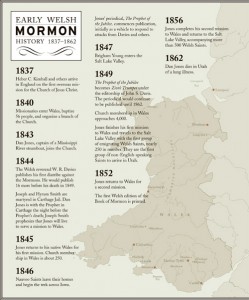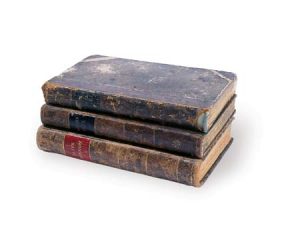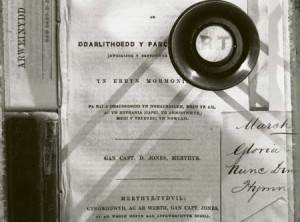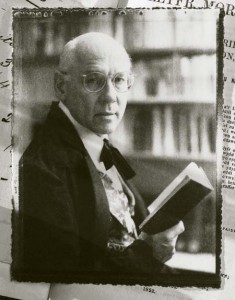By Lisa Ann Jackson, ‘95
It all started typically enough. Ronald D. Dennis, ’64, was rummaging around in his family history more than 30 years ago when he happened upon the story of William Howells. In 1847 Howells was a lay Baptist preacher in Aberdare, Wales, who had heard quite a lot about a pesky sect called the Mormons. Several of his colleagues had a great deal to say about the Mormons, and there was a Mormon who had a great deal to say in return.
This Mormon was the venerable Captain Dan Jones, an ancestor of Dennis. He was a Welshman who immigrated to the United States, joined The Church of Jesus Christ of Latter-day Saints in 1843, and went back to his homeland as a fiery missionary in 1845. This Mississippi River steamboat captain also became a prolific writer as he defended the tenets of the Church against attacks from Welsh Baptist pulpits.
It was one of Jones’ written defenses, a pamphlet called A Review, that caught the attention of William Howells. The Reverend Edward Roberts had preached a double header against Mormonism, and Jones wrote a detailed 40-page response. Howells read the response and was convinced of the Mormon position. He sought out the author and was baptized.
“I decided if a pamphlet had that kind of impact on somebody, I’d like to know what it says,” says Dennis, a BYU professor of Portuguese. He went looking for the pamphlet, and the journey has turned Dennis into the foremost historian of 19th-century Welsh Latter-day Saints. It has also made him fluent in the Welsh language and has opened the world of early Church history in Wales to scholars and family historians alike.
Learning to Read
Dennis found the pamphlet easily enough in the National Library of Wales, but he couldn’t read it. The pamphlet was written in Welsh and had never been translated into English.
He went the conventional route to begin with and tried to have it translated. Unfortunately, he couldn’t find any local Welsh speakers who were comfortable with 19th-century Welsh. After several dead ends, Dennis decided that if he wanted the job done he was going to have to do it himself.
So the professor did the only logical thing he could think to do: he took up Welsh.
It was slow going at first. He tried the self-teach method, but it didn’t last long. Dennis is fluent in Portuguese and Spanish, and he studied German, French, and Latin in graduate school. His opinion of Welsh? “I discovered that, yes, it is darn hard.”
So he took the next logical step: a sabbatical from his teaching post at BYU. He moved his family to Wales for six months during the 1970s and immersed himself in Welsh. After many return visits over the next several years, he was finally able to do some translation work.
Three decades later, Dennis has translated more Welsh Mormon writings than anyone, and he is the niche field’s leading scholar.
“He has opened up this field of study to an infinitely wider number of scholars, students, and general readers by using his mastery of the Welsh language and his incisive critical and editorial skills,” says D. L. Davies, a member of the language faculty at Afon Taf High School in Merthyr Tydfil, Wales, with specific research interests in 19th-century emigration. Davies’ interests stem from the same motivation as Dennis’—only from the other side of the pulpit. Davies’ great-great-great-grandfather Llewelyn Howells was a stalwart Baptist who stood out against the Reverend David Bevan Jones when Jones and colleague William Howells espoused Mormonism. Much to the dismay and consternation of his parish, the Reverend Jones turned his chapel over to his newfound faith. Davies’ ancestor joined the charge to take back the chapel. They were successful, and Davies attended church there as a boy.
Introduced by a colleague at the National Library of Wales, Davies and Dennis have enjoyed a long friendship and collaboration, despite their feuding pasts. Davies recognizes Dennis as a “towering master” of the earliest Church mission to Wales. In a foreword for one of Dennis’ translations, Zion’s Trumpet, Davies says, “Not only has he single-handedly transformed one of the most neglected aspects of Welsh—and possibly Mormon—history into a veritable library of knowledge . . . , he has also mastered the language of his Welsh ancestors with remarkable success. Both Welsh and Mormon scholarship are hugely in his debt.” In Their Own Words
In Their Own Words
While Dennis’ contributions to the study of Welsh Mormon history have truly been sizable, he has had a bit of help from the early Welsh Mormons themselves. They were a prolific bunch. They valued their language and culture and kept detailed records through private correspondence and journals as well as published periodicals and pamphlets.
In Dennis’ personal quest to read these writings, he became incurably committed to helping others discover the gems he was finding. “There were all these stories that were not well known, and I thought, Who’s making these known?” That’s really Dennis’ motivation—to see that these stories are told both to descendants of Welsh Latter-day Saint immigrants and to Church members in general.
In his translations he has uncovered heart-wrenching tales, practical guides for emigrating, and passionate sermons. The first two groups of Saints to leave Wales for Zion came across in 1849 in what Dennis calls “arguably the best-documented crossings in Mormon history.”
Among the surviving documents of these and subsequent crossings is a pamphlet called The Guide to Zion, written by Captain Dan Jones, the appointed leader of the Church in Wales. In the guide Jones tells would-be emigrants how to prepare for their journey, both temporally and spiritually, giving advice such as “Have a bottle or two of consecrated olive oil; and as much faith as possible.” He adds, “Have a few bottles of castor oil for the children, and for the weak in faith.”
He gives travelers coming from pastoral Wales to the bustling port of Liverpool guidelines before boarding the ships, cautioning mothers to keep close track of their children lest “kidnappers snatch them from your side where you will not see them again.” In his counsel for the sea, he tells young women to beware of sailors, who “will try to be kind to you in many ways. . . . Do not give them a chance, and do not socialize with them; beware of their company as of the gates of death!” He also offers detailed instructions for driving oxen, a feat quite unfamiliar to most Welshmen of the day.
He concludes his guide with a last point of wisdom: “There is almost nothing that determines the character of man in the opinion of his fellow travelers as much as his behavior with respect to his duties on this journey. The obedient person has never lost his good name.” As the journey ensued for the first two crossings—on board the Buena Vista and the Hartley—so did the human drama. From the ships came stories of miraculous healings as well as inevitable death. Church missionary William Phillips spent a few days on the ship with the Buena Vista Saints as they waited dockside for their departure. He reported, “I saw some of the Saints at times taken sick; but no sooner were hands laid on them but what they were restored immediately; and I can bear witness that I have never seen more of the power of God than I saw on the ship.”
As the journey ensued for the first two crossings—on board the Buena Vista and the Hartley—so did the human drama. From the ships came stories of miraculous healings as well as inevitable death. Church missionary William Phillips spent a few days on the ship with the Buena Vista Saints as they waited dockside for their departure. He reported, “I saw some of the Saints at times taken sick; but no sooner were hands laid on them but what they were restored immediately; and I can bear witness that I have never seen more of the power of God than I saw on the ship.”
The true test of faith came later in their journey. After crossing the Atlantic, the Saints took a steamship up the Mississippi River and then to the Missouri. Cholera was rampant and claimed the lives of one-fifth of the group of Welsh Saints.
John Ormond was among those on board the Hartley, which left Liverpool a week after the Buena Vista. He joined the Church in Pembrokeshire, Wales; however, his wife was not enthusiastic about his newfound faith and even less enthusiastic about his plan to emigrate. She refused to go. Ormond was determined and took five of their eight unmarried children. Cholera struck the family on the Missouri River and claimed 3-year-old Ellinor and her sister Letitia. Another child, Dorothy, died at Council Bluffs.
This first group of Welsh emigrants arrived in the Salt Lake Valley at the end of 1849.
“Mad, Presumptuous Doctrines”
Dennis uncovered another scene of human drama in his studies—the ongoing battle between established Baptist congregations and the parishioner- pilfering Mormon missionaries. The battleground was the popular press.
The Reverend W. R. Davies of Dowlais, Wales, first encountered the Latter-day Saints when he lost a member of his congregation to them. He would become one of their most vocal foes, regularly using religious periodicals—in addition to sermons and letters—to launch his offensives. Davies published 17 articles against the Church over a five-year period.
At one point in 1846, Davies declared in The Baptist, “The mad, presumptuous doctrines which you proclaim are beneath the consideration of every man who has common sense.” Captain Jones attemped to respond to Davies’ claims, but the periodicals publishing Davies’ articles weren’t as accommodating to Jones. So in July 1846, Jones created his own periodical, the Prophet of the Jubilee,which was later renamed Zion’s Trumpet.
The slinging continued over a period of several years, with polemic fervor from both sides. Davies called the Mormons “foolish and mad men” who “baptize at night . . . stark naked!” Jones accused Davies of “foolish and erroneous accusations.” Davies referred to the Latter-day Saints as “19th-century Satanists.” Jones called Davies a “gossip-monger” and his arguments “idiocy.” Davies predicted that these “presumptuous people will not continue much farther; their foolishness is apparent to all.” Davies died in 1849 of cholera. By the end of the 19th century, an estimated 12,000 Welsh had joined the Church.
Of that 12,000 about 5,000 set out to join the Saints in Zion. They brought with them skills as masons, iron workers, and musicians. Today their legacy can be seen throughout the Church of Jesus Christ, from the stonework of the Manti and St. George Temples to the voices of Mormon Tabernacle Choir members, many of whom descend from Welsh ancestry. The choir itself grew out of a small group established by Welsh immigrant John Parry.
But perhaps the most practical contribution to come from Welsh Mormon posterity is Carlyle Harmon’s simple invention: disposable diapers.
Bread and Butter
While Welsh history is his love, Portuguese is still Dennis’ bread and butter. He first learned Portuguese on a Church mission to Brazil as a young man. He later received grants to do graduate studies because Portuguese was considered a “critical” foreign language on the college level and there was a shortage of professors. Dennis joined the BYU faculty in the 1960s.
He admits to having slighted Portuguese in the name of his avocation, but he still actively teaches Portuguese. After returning to Brazil as a mission president in the late 1990s, Dennis developed a teaching method that he hopes to fine-tune and present to the Missionary Training Center. His primary emphasis in Portuguese is listening comprehension.
BYU does not have a Welsh program, but Dennis teaches two levels of Welsh as well as family history classes and an occasional religion class. His spare time is spent translating, compiling, and otherwise championing Welsh Mormon history. His summers are spent leading tours with a company he established to showcase early Church and other historical sites in Wales, England, and Scotland.
It’s clear Dennis comes by his passion for all things Welsh honestly. The more you read about the feisty Dan Jones, the more you can see how the generations would have molded Jones’ traits into the tenacious and meticulous Ron Dennis. Jones labored for pages picking apart every word of an assault from this reverend or that. Dennis has labored for volumes to recapture those detailed rebuttals.
“The motivation, of course, is the void,” he says. “Nobody else has done this. There are lots of other people working on other areas I could be involved in, but this has nobody, absolutely zero.” That’s a detail that plagues Dennis a bit. Despite his fervor, it is Dennis’ hope that someone else will take up the cause. He hopes to light the fire in some other Welsh descendant and see him or her go forward with the torch. “That’s one of the reasons I teach the Welsh courses—to get a convert,” says Dennis, “someone who has the fire burning as much as I do.”
That’s a detail that plagues Dennis a bit. Despite his fervor, it is Dennis’ hope that someone else will take up the cause. He hopes to light the fire in some other Welsh descendant and see him or her go forward with the torch. “That’s one of the reasons I teach the Welsh courses—to get a convert,” says Dennis, “someone who has the fire burning as much as I do.”
So far he has none, so Dennis continues with no end in sight. The prolific Welsh men and women left plenty for him to do. There are biographies to be written, documents to be translated, and stories to be recovered.
Dennis does give one small warning to would-be torchbearers: “There’s no money in it. It’s a labor of love.”
Lisa Ann Jackson is an editor for the Liahona magazine.
PUTTING WELSH SAINTS ON THE WEB
By Lisa Ann Jackson, ‘95
His goal is straightforward: Document all 12,000 Welsh men and women who joined the Church in the 19th century—complete with photos, bios, and names of living descendants. He’s getting close to 4,000.
If you go wandering around the site, you’ll find everything from one-line entries to novel-length biographies. But what Dennis, ’64, would like you to find is his e-mail address and contact information.
To date, his method of collecting names and information has been to actively seek out people with Latter-day Saint Welsh ancestry. But he wouldn’t mind if people sought him out. “It takes a lot of time to find people,” Dennis says.
Dennis hopes the site will become a clearinghouse for all things early Welsh Mormon. “I’m just glad I lived long enough to have these technological tools,” says Dennis. “My dream is to have the entire list online—you scroll down it, find your ancestor, click on it, and there’s what I have on him or her.” The site includes names, dates, stories, and photos, as well as contact information of descendants.
Dennis intends to keep adding to the list as long as he can. “When I retire my life won’t change a whole lot,” he says. “I’ll just get an emeritus office and one of those people who knows about computers and just keep doing what I’m doing.”
EARLY WELSH MORMON HISTORY 1837-1862
1837
Heber C. Kimball and others arrive in England on the first overseas mission for the Church of Jesus Christ.
1840
Missionaries enter Wales, baptize 56 people, and organize a branch of the Church.
1843
Dan Jones, captain of a Mississippi River steamboat, joins the Church.
1844
The Welsh reverend W. R. Davies publishes his first diatribe against the Mormons. He would publish 16 more before his death in 1849.
Joseph and Hyrum Smith are martyred in Carthage Jail. Dan Jones is with the Prophet in Carthage the night before the Prophet’s death; Joseph Smith prophesies that Jones will live to serve a mission to Wales.
1845
Jones returns to his native Wales for his first mission. Church membership in Wales is about 250.
1846
Nauvoo Saints leave their homes and begin the trek across Iowa.
Jones’ periodical, The Prophet of the Jubilee, commences publication, initially as a vehicle to respond to attacks from Davies and others.
1847
Brigham Young enters the Salt Lake Valley.
1849
The Prophet of the Jubilee becomes Zion’s Trumpet under the editorship of John S. Davis. The periodical would continue to be published until 1862.
Church membership in Wales approaches 4,000.
Jones finishes his first mission to Wales and travels to the Salt Lake Valley with the first group of emigrating Welsh Saints, nearly 250 in number. They are the first group of non-English-speaking Saints to arrive in Utah.
1852
Jones returns to Wales for a second mission.
The first Welsh edition of the Book of Mormon is printed.
1856
Jones completes his second mission to Wales and returns to the Salt Lake Valley, accompanying more than 500 Welsh Saints.
1862
Dan Jones dies in Utah of a lung illness.









